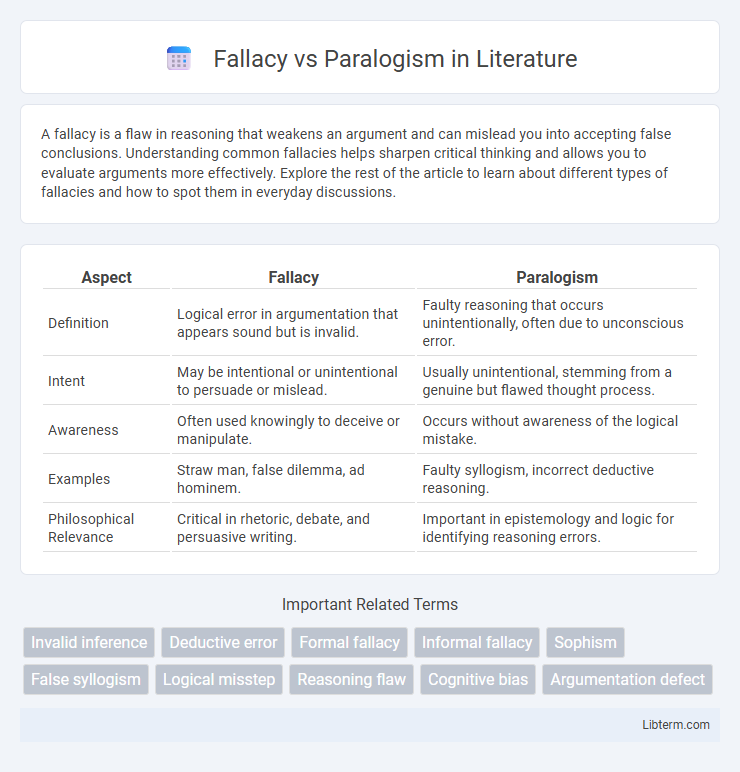A fallacy is a flaw in reasoning that weakens an argument and can mislead you into accepting false conclusions. Understanding common fallacies helps sharpen critical thinking and allows you to evaluate arguments more effectively. Explore the rest of the article to learn about different types of fallacies and how to spot them in everyday discussions.
Table of Comparison
| Aspect | Fallacy | Paralogism |
|---|---|---|
| Definition | Logical error in argumentation that appears sound but is invalid. | Faulty reasoning that occurs unintentionally, often due to unconscious error. |
| Intent | May be intentional or unintentional to persuade or mislead. | Usually unintentional, stemming from a genuine but flawed thought process. |
| Awareness | Often used knowingly to deceive or manipulate. | Occurs without awareness of the logical mistake. |
| Examples | Straw man, false dilemma, ad hominem. | Faulty syllogism, incorrect deductive reasoning. |
| Philosophical Relevance | Critical in rhetoric, debate, and persuasive writing. | Important in epistemology and logic for identifying reasoning errors. |
Introduction to Fallacy and Paralogism
A fallacy is a flaw in reasoning that undermines the logical validity of an argument, often used unintentionally or to deceive. A paralogism is a specific type of fallacy where incorrect reasoning occurs due to a logical error, but the conclusion might still appear valid. Understanding the distinction helps identify errors in argumentation and improves critical thinking skills.
Definitions: What is a Fallacy?
A fallacy is an error in reasoning that renders an argument logically invalid or misleading, often used unintentionally or to deceive. It involves flawed logical structures or irrelevant information that weakens the argument's persuasiveness or truthfulness. Fallacies can be formal, relating to the argument's form, or informal, based on content and context errors.
Definitions: What is a Paralogism?
A paralogism is a type of reasoning error where the conclusion is reached through faulty logic, but the mistake remains unintentional or unnoticed by the thinker. Unlike common fallacies, which rely on misleading or deceptive arguments, paralogisms stem from genuine errors in the inferential process. Understanding the distinction helps in identifying unintentional logical mistakes versus deliberately fallacious reasoning.
Key Differences Between Fallacy and Paralogism
Fallacies are errors in reasoning that appear logically valid but lack soundness, often used to deceive or mislead in arguments, whereas paralogisms are unintended logical errors resulting from faulty inference without deceptive intent. Fallacies typically involve rhetorical manipulation or invalid argument structures, while paralogisms arise from cognitive mistakes or misunderstandings in logic. Understanding the distinction aids in critical thinking by differentiating between deliberate fallacious tactics and honest reasoning errors.
Types of Fallacies in Reasoning
Fallacies in reasoning comprise formal fallacies, arising from flawed logical structure, and informal fallacies, stemming from errors in content or context such as ad hominem, straw man, and false dilemma. Paralogisms differ by being logically flawed arguments often due to unconscious mistakes, lacking the deliberate intent found in fallacies. Recognizing types of fallacies like slippery slope, circular reasoning, and hasty generalization enhances critical thinking and helps avoid invalid conclusions.
Examples of Paralogisms in Everyday Arguments
Paralogisms often appear in everyday arguments when flawed reasoning masquerades as logical proof, such as assuming causation from mere correlation or misapplying deductive rules. A common example is arguing that since two events occur together, one must cause the other, reflecting a false cause paralogism. Other frequent cases include hasty generalizations drawn from insufficient data or circular reasoning where the conclusion is presupposed in the premises.
Intentional vs Unintentional Errors in Logic
Fallacies are intentional errors in logic designed to deceive or persuade through misleading reasoning, often found in rhetorical arguments. Paralogisms, by contrast, are unintentional logical mistakes arising from faulty reasoning or misunderstandings, typically occurring in philosophical or mathematical contexts. Understanding the distinction aids critical thinking by highlighting the deliberate nature of fallacies versus the inadvertent nature of paralogisms.
The Role of Fallacy and Paralogism in Critical Thinking
Fallacy and paralogism significantly influence critical thinking by highlighting errors in reasoning, with fallacies being misleading arguments often used intentionally or unintentionally to deceive, and paralogisms representing unintentional logical mistakes in argumentation. Recognizing fallacies enables critical thinkers to challenge faulty arguments and avoid cognitive biases, while identifying paralogisms sharpens analytical skills by exposing genuine reasoning lapses. The distinction between these concepts fosters more rigorous evaluation of arguments, strengthening decision-making and problem-solving processes in complex discourse.
Common Misconceptions About Logical Errors
Fallacies are errors in reasoning that appear logically valid but fail due to flawed argument structures, often rooted in emotional appeals or irrelevant information. Paralogisms differ as unintentional logical mistakes caused by a misunderstanding or misuse of inferential rules, lacking the deliberate intent found in fallacies. Common misconceptions include confusing fallacies with paralogisms, assuming all logical errors denote intentional deception, and overlooking that some fallacies can be persuasive despite their invalidity.
Conclusion: Importance of Distinguishing Fallacy from Paralogism
Distinguishing fallacy from paralogism is crucial because fallacies involve errors in reasoning that invalidate arguments, while paralogisms are unintentional logical mistakes made without deceptive intent. Recognizing this difference enhances critical thinking skills and improves the accuracy of evaluating argumentative validity in philosophy and logic. Clarity in identifying these errors prevents misinterpretation of reasoning processes and supports more rigorous intellectual discourse.
Fallacy Infographic

 libterm.com
libterm.com